SPACEFLIGHT China and Russia lunar partnership
The new moonwalkers
A new lunar base is being planned to be jointly built by China and Russia as part of ambitious plans to explore the Moon. EUGENE GERDEN finds out more.
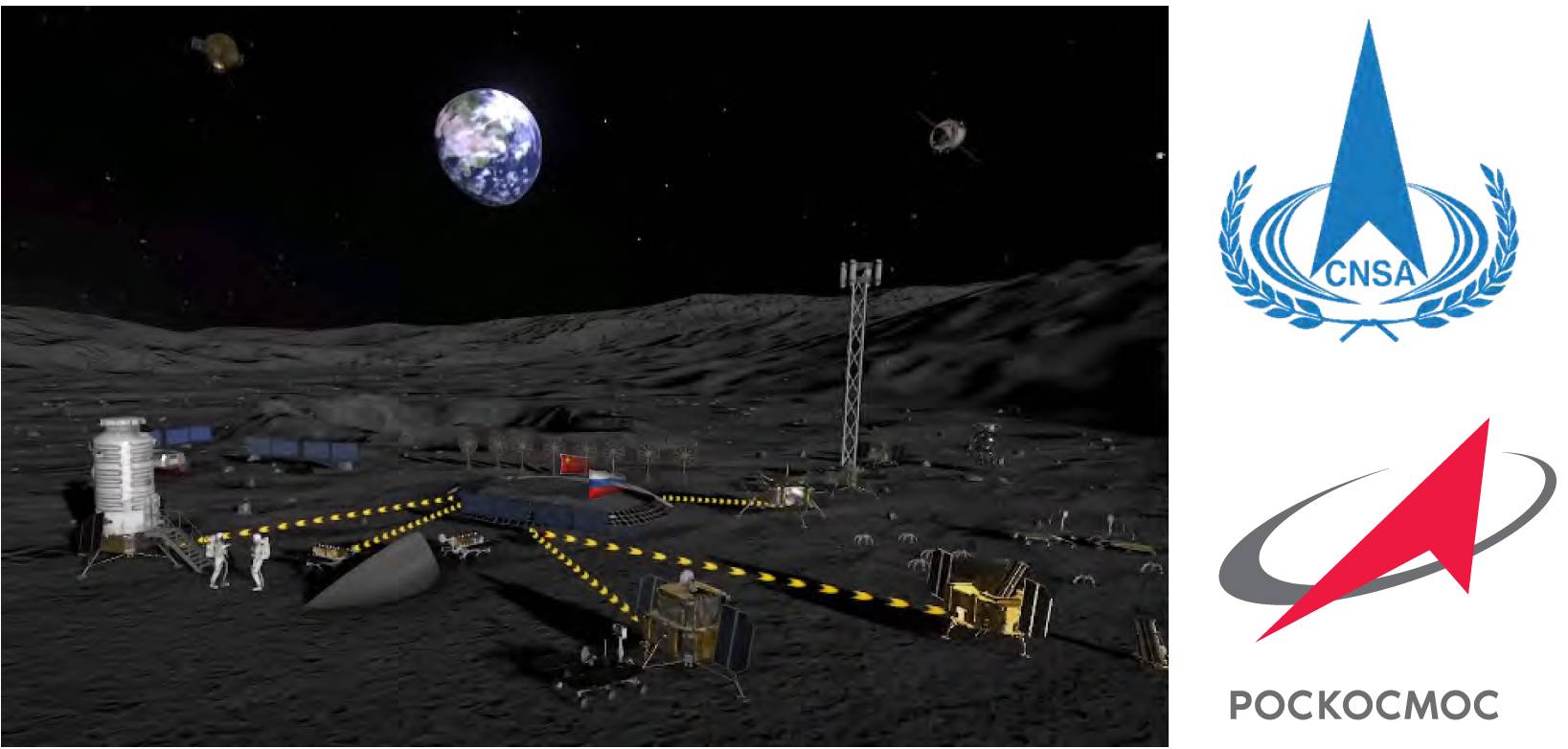 Roscosmos
Roscosmos
In March, China and Russia signed a memorandum to jointly build a lunar space station. According to Sergei Savelyev, Deputy General Director of the department of International Co-operation of Roscosmos, a roadmap of the project was officially presented by the partners during the GLEX global space exploration conference in St. Petersburg in June.
Building of the new lunar station (dubbed the International Science Lunar Station (IAS)) was also part of a wider agreement of joint space exploration which was signed between the partners in November 2017 and designed for the period of 2018-2022. The programme consists of six sections, one of which is dedicated to research on the Moon.
Currently, the partners are continuing consultations regarding the project and assessing potential difficulties during its implementation, associated with the need for design of some conceptually new technologies and apparatuses, including space modules and systems for soft landing – all of which will be built almost from scratch.
According to analysts, the successful implementation of the project will pave the way for regular crewed flights to the Moon within the next decade. The majority of observers believe the project has a significant chance of being successful.
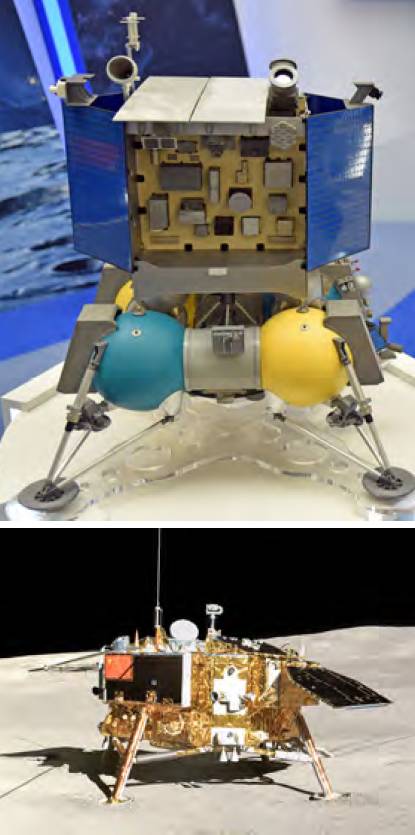 Top: A model of Russia’s ‘Luna-27’ probe. Above: The ‘Chang’e-4’ lander. CSNA/Siyu Zhang/Kevin M. Gill Pline/Wikipedia
Top: A model of Russia’s ‘Luna-27’ probe. Above: The ‘Chang’e-4’ lander. CSNA/Siyu Zhang/Kevin M. Gill Pline/Wikipedia
In recent years China has achieved great progress in the field of space exploration, and is planning the implementation of some major projects, such as Mars missions, in the years to come.
One example of Chinese achievements is the publishing of the first complete topographic map of the Moon’s surface (with a resolution of seven metres based on images of the second Chinese lunar mission ‘Chang’e-2’ (‘Moon Princess-2’) by the Chinese Department of Defense Science, Technology and Industry in February 2012.
In addition, the third mission, ‘Chang’e-3’, which in December 2013 made a soft landing on the Moon (37 years after the landing of the Soviet Luna-24 AMS), delivered the Yutu spacecraft, Jade Rabbit, to the Moon.
In 2019, China was the first country to land the ‘Chang’e-4’ robotic probe on the far side of the Moon. The Yutu-2 rover, which arrived with it, remains currently in operation.
At the end of 2020, the ‘Chang’e-5’ spacecraft took samples of lunar soil and delivered them to the Earth. Previously, only the USSR and the US managed to do this. In addition, as part of that mission, the first-ever automatic docking in lunar orbit was conducted. The current lunar programme, which is implemented by China involves the landing of Chinese astronauts on the Moon by 2028.
At the end for three years in a row, China has been the world’s leading country in terms of its number of rocket launches, with China’s space budget being the second largest after the US.
While Chinese investments in its space and lunar programme significantly exceed those of Russia, the lack of technologies for its implementation creates conditions for co-operation between both countries. That means that China could be interested in using space technologies developed by Russia (and earlier, the USSR) over many years of space exploration, as Russian and Soviet space enterprises have rich experience in the production of unique spaceflight technology and equipment that has worked successfully in many projects.
In addition, Russia has extensive experience in the construction and operation of inhabited orbital stations. This is very useful for a lunar orbital station – a bridgehead for the delivery of cargo and crews to the Moon and back. For this purpose, Russian elements of the ISS could be used.
As for Russia, it has long-standing scientific and technical ties with Beijing in the field of astronautics. For example, Chinese designers used Russian developments to create rocket engines, while the Chinese Yutu-2 lunar rover has Russian-made radioisotope generators in its structure. Russia has its own lunar exploration programme which will begin to be implemented this year with the launch of the ‘Luna-25’ mission from the Vostochny Cosmodrome. That will become the first lunar lander in the history of modern Russia, after the launch of a similar space probe in the USSR in 1976.
The launch of the first ‘Luna-25’ is scheduled for July 2022, to conduct research of the Moon’s surface and to drill in the area of the South Pole. According to scientists, this is an important task as it will allow it to estimate water ice deposits which are concentrated in this area of the Moon that could be useful for the building of a future lunar base.
In 2024, Russia plans to conduct the launch of its second spacecraft of the Luna series – ‘Luna-26’ – which is expected to be conducted in conjunction with the Chinese ‘Chang’e-7’ mission, and a year later – ‘Luna-27’ jointly with China’s ‘Chang’e-8’.
Finally, the ‘Luna- 28’ mission – to send a sample of lunar ice to Earth is likely to be completed in 2026 or 2027, while the launch of a heavy lunar rover as part of the ‘Luna-29’ mission will probably be completed closer to 2030.
All these probes will be equipped with high-resolution cameras, geo-radars, neutron sensors, spectrometers, seismometers, magnetometers, water and hydrogen isotope analysers and other devices that are currently being developed by scientists at dozens of scientific institutes in Russia and China.
It is also planned that the ‘Luna-27’ station could become the basis for Russia’s future probes, as an uncrewed station on the Moon can prepare the ground for astronauts to land and create a lunar settlement.
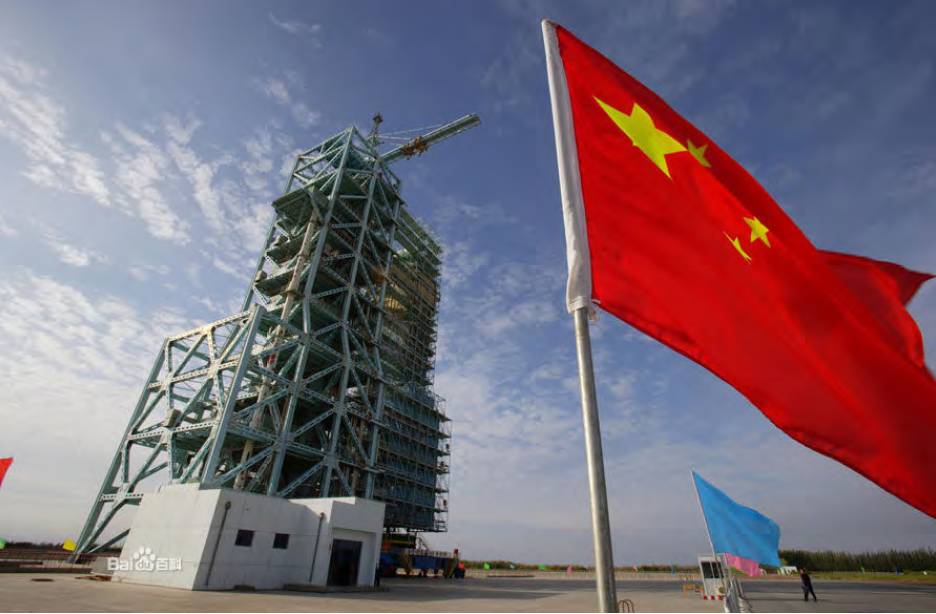 China’s Jiuquan Satellite Launch Center. CNSA
China’s Jiuquan Satellite Launch Center. CNSA
According to analysts, when the partners are technically ready to make a crewed launch, this automated station will be well suited as the first target of the lunar lander and may become the basis for a crewed lunar base.
However, neither China and Russia have experience in building permanent lunar bases (as has no other country in the world). It will require the partners to develop technologies for completely new tasks, such as arranging the living environment on the Moon, producing electricity and obtaining oxygen, as well as hydrogen for rocket fuel. The prospects for such a grand project largely depend on how successfully Russia and China complete the joint first stage of the project.
Interestingly the launches will not need super-heavy rockets, with the Soyuz-2.1b launcher expected to be the booster for the majority of planned launches.
The project is considered very important by the partners as, in addition to the considerable national prestige it will bring and the beginning of regular flights to the Moon, it could be associated with other more important benefits for them.
As Vladimir Surdin, an astronomer and associate professor at Moscow State University, stated in an interview with the Russian-language Eurasianet, the country that will lead in Moon research and development will demonstrate its technological superiority in a variety of spheres including electronics and weapons etc.
According to Surdin, for scientists, the Moon has always been an intriguing object of study, due to the existence of various hypotheses of its origin. As Surdin added, even as of now, the surface of the Moon has been studied to a depth of only two metres but no deeper. An important task that could be implemented by the partners, according to him, is the beginning of a geological exploration of the Moon at greater depths.
In the meantime, according to Vitaly Egorov, a well-known Russian scientific blogger and an expert in the field of aerospace during the first stage of the project, the partners would have considered building an automated research base (that could be established as a result of landing several spacecraft, which have interaction with each other) at the South Pole of the Moon. As Egorov added, the plans for its construction have have already been unveiled by the Chinese side some time ago, with the scheduled completion by 2030.
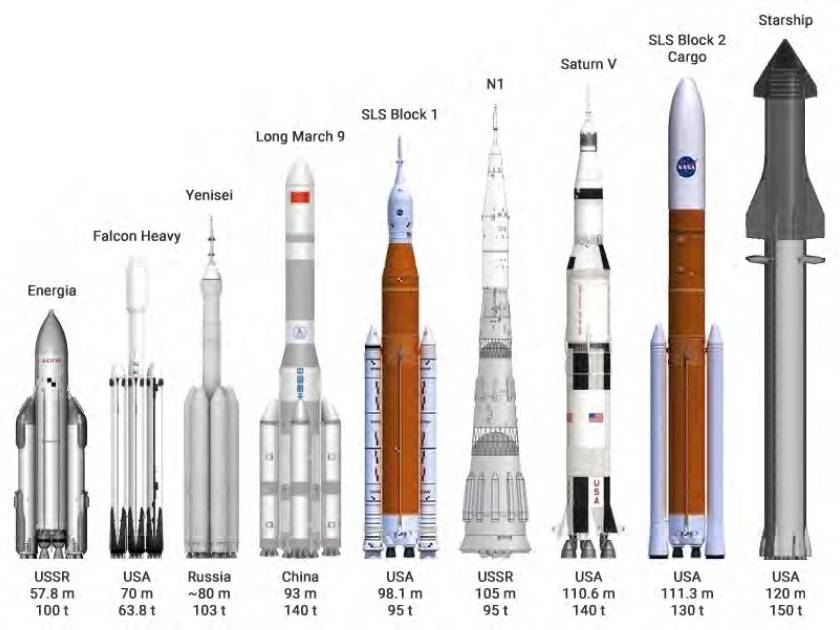 How China’s Long March and rockets compare to the rest of the world’s. Wikipedia/Thorenn
How China’s Long March and rockets compare to the rest of the world’s. Wikipedia/Thorenn
There is also a possibility that the Russian-Chinese IAS project may involve participation of other countries, particularly those from the Middle East (many of which have increased investments in their space programmes in recent years), such as India (despite its traditional tensions with China) and even Iran and Turkey.
According to analysts, if the ‘eastern bloc’ is created, it will become a rival to a number of countries participating in NASA’s ‘Artemis’ programme, although it will still be unlikely to overtake competitors on that programme.
So far, Russia and China have experienced similar problems in ambitions to send humans to the Moon. Implementation of the Russian crewed lunar programme, which was initially announced in 2014, is seriously delayed, which is also due to the current problems with the design of a superheavy Yenisei rocket, which is initially planned for launches. The main reason is the high cost of the project, which in 2016 was estimated at about RUB 1.5tn, is higher than the cost of the entire Russian federal space programme. In addition, according to the General Director of the rocket and space centre ‘Progress’, Dmitry Baranov, one of Russia’s leading companies in the field of space science and aerospace research, it is important to adjust the design and performance of the rocket.
At the same time the development of the Chinese super-heavy lunar rocket Long March 9 is also at its initial stage, while its test flight will take place no earlier than 2030.
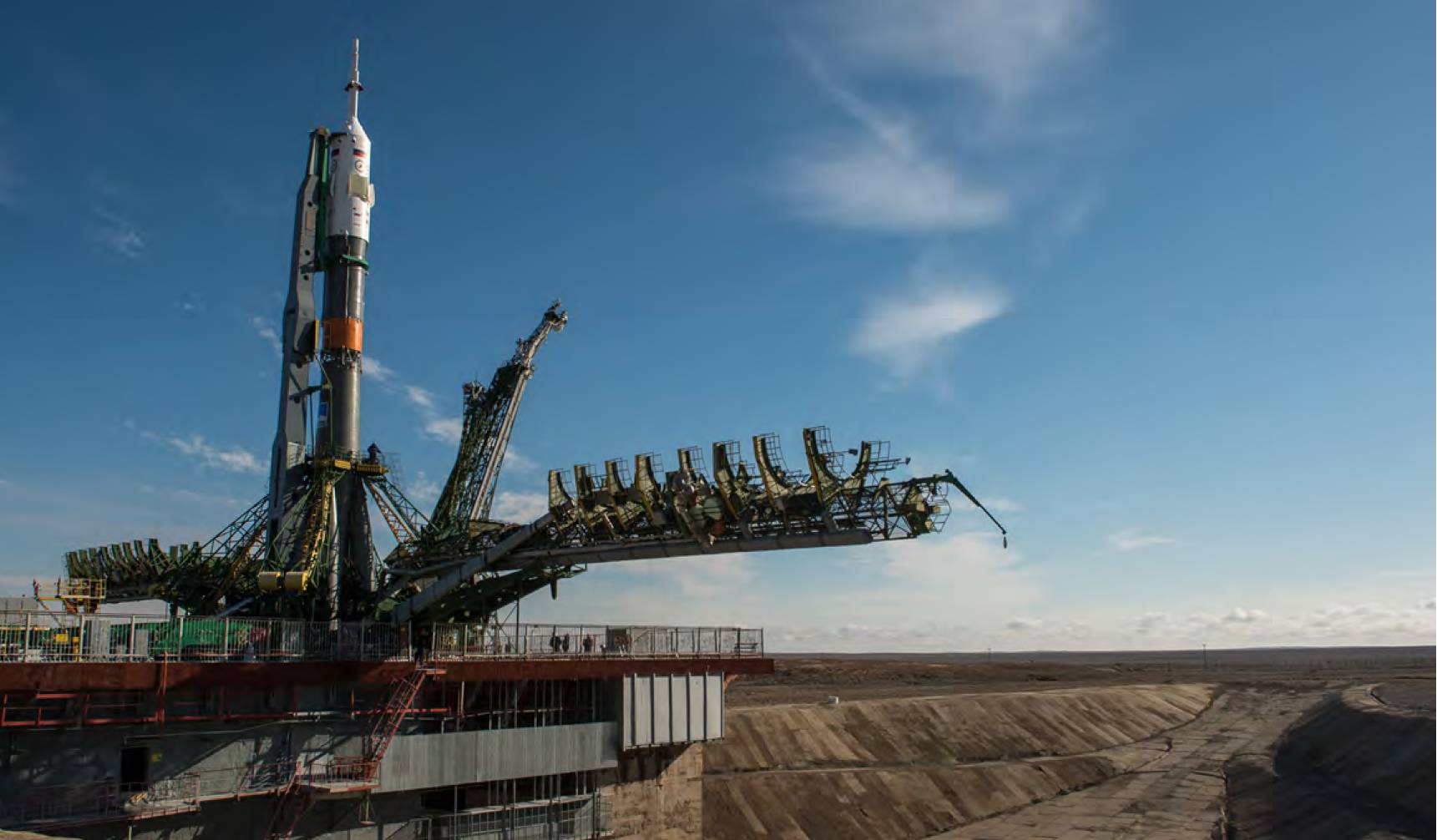 The Soyuz TMA-16M spacecraft is seen here after having been rolled out by train to the launch pad at the Baikonur Cosmodrome, Kazakhstan. (NASA/Bill Ingalls
The Soyuz TMA-16M spacecraft is seen here after having been rolled out by train to the launch pad at the Baikonur Cosmodrome, Kazakhstan. (NASA/Bill Ingalls
Until recently, many products of the Russian space industry had the status of being irreplaceable. However, the loss of the country’s monopoly on the flights to the International Space Station and the end of purchases of rocket engines by the US had a negative effect on Russia’s prestige.
Moreover, ten years ago, China’s attempt to send the Inho-1 satellite to Mars with the help of Russia’s Phobos-Grunt interplanetary probe failed: the spacecraft failed to cross the Earth’s orbit and burned up in the upper atmosphere. Since then, China has made a breakthrough in its own independent research of the Red Planet.
Most of Russian space achievements dated from the Soviet era, while China has its own Martian spacecraft, preparing to land the rover. In this regard, it will be difficult for Russia to offer anything conceptually crucial and important to the Chinese side in this joint ISA progrramme.
Indeed, a while ago Russia had plans to participate in NASA’s Deep Space Gateway orbital lunar station project. However, it later decided to leave the project.
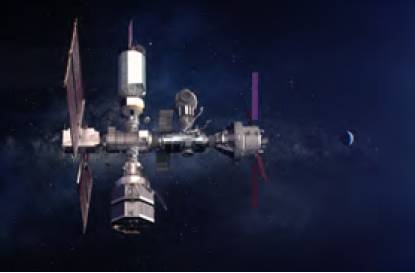 NASA’s Deep Space Gateway orbital lunar station. NASA
NASA’s Deep Space Gateway orbital lunar station. NASA
Commenting on that decision, Dmitry Rogozin, head of Roscosmos, said that: “Deep Space Gateway is positioned as the entirely American project with limited involvement of external partners, while Russia is not interested in such an option”.
In addition, according to Rogozin, in contrast to the US, which is mainly interested in the research of lunar orbit, the sphere of interest to Russia is primarily related with the Moon’s surface.
According to industry experts, the biggest obstacles to Roscosmos were related to its minor role in the Deep Space Gateway project being limited to the design of a gateway module and life support systems for the station, although the Russian state corporation insisted on an equal partnership.
Still, as analysts of the Russian Izvestia business paper believe, even if an agreement was reached, its actual implementation would probably be blocked in the US Congress.
Insiders believe both China and Russia will be able to challenge the current leadership of the US in the ‘second lunar race’, although that could be complicated by the existing significant technological gap with the US, as well as deep disagreements between the partners. More deeper co-operation between the sides is prevented by the unwillingness of the Chinese to allocate significant financial resources to the project, while Russia is set to transfer much of its technologies to China.
In addition, according to analysts, the US has also achieved serious progress in the field of lunar exploration in recent years. This is reflected by the almost complete design of the SLS launch vehicle for the flight to the Moon. In addition, a test launch of a potentially crewed spacecraft for Artemis is expected soon.